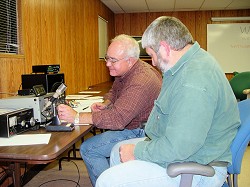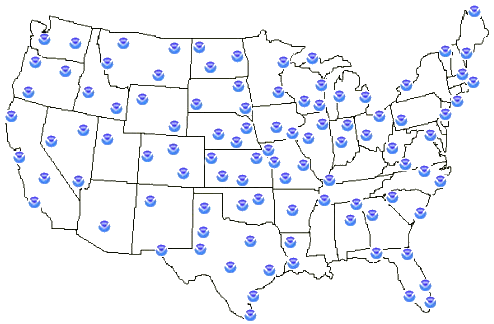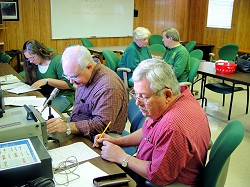|
The National Weather Service, in cooperation with the Amateur Radio Relay
League, sponsored Skywarn™ Recognition Day from 6 pm CST on November 30th to 6 pm CST on December 1st, 2007.
The purpose of the event was to recognize the vital public service contribution that amateur radio operators make during National Weather Service
severe weather warning operations. It is important to remember that these radio operators are volunteers.
They give their time and use of their equipment as a public service.
 |
This was the ninth year of the event. Amateur radio operators, commonly known as HAMs, participated
at over 100 National Weather Service offices across the country. |
| In the picture (from front to back): Steve Porter (AE5SP) and Fred Shay (N2JAS) contact other
HAM radio operators during Skywarn™ Recognition Day, 2007. Click to enlarge. |
In Arkansas, a special radio call sign...W5A...was assigned to the HAMs at North Little Rock. The HAMs
attempted to reach as many other weather offices as possible and other participating contacts around
the world.
 |
| In the picture: National Weather Service offices that participated in Skywarn™ Recognition
Day, 2007. |
In actual emergencies, the HAMs are often called upon for their radio skills. For example, during severe weather outbreaks, HAMs
operate a base station at the National Weather Service to gather reports of severe weather across Arkansas. Watches,
warnings, and statements are broadcast from the base station to HAMs around the state.
In addition to gathering severe weather reports in their areas, many HAMs have been certified as severe weather spotters. In
fact, the names of several hundred HAMs are found in the spotter rolls.
| In the picture: Steve Williams (WB4ZCP) made contact over the internet via EchoLink on Skywarn™ Recognition
Day, 2007. Click to enlarge. |
 |
During the devastating tornado outbreak of January 21-22 1999, the HAMs provided numerous invaluable reports of tornado
touchdowns. These reports served as starting points for many of the National Weather Service damage surveys. Since so many tornadoes occurred, it is likely that
some of the paths would never have been found had it not been for the reports that the HAMs provided. More recently, the
HAMs were instrumental in gathering reports surrounding the tornado outbreak of November 27 2005.
 |
In the picture (clockwise from front right): Jerry Sparrow (WA5LOC), Fred Shay (N2JAS) and Marlene Kessler (KE5HQU) were busy talking and logging contacts while
Pat Dixon (N5ZSN) and Jerry Dixon (N5WVI) looked on. Click to enlarge. |
In cases of widespread communications outages, the HAMs can also serve as a vital link between National Weather Service offices when
normal communications circuits are out of service. For example, a large earthquake along the New Madrid fault...which runs from
Illinois to Arkansas...could very well knock out most normal communications. In such a situation, HAMs would operate their radio equipment and
serve to link National Weather Service offices.
---------------------------------------------------
For more about Skywarn™, visit our
Skywarn™ page by clicking here.
For more information concerning Skywarn™ Recognition
Day...visit the official event homepage
by clicking here.
|


